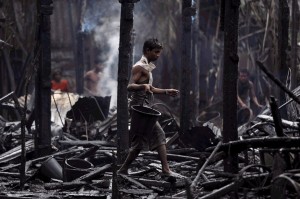June 26, 2012 at 5:30 am MMT
MMSY News
Yangon – The Arakan conflict in western Burma might have taken many more lives than the official report of 50 plus deaths. According to sources from Arakan state, more Rohingyas have been killed, but an exact number of deaths and displaced people is difficult to obtain as the government has barred journalists and relief organizations from visiting various places.
According to a letter submitted to a Member of Parliament U Shwe Maung by a Muslim community representative from the town of Sittwe, 159 Rohingyas were killed and 1,240 people are missing. The list that accounts for the Sittwe area from June 9 to 18 shows that 800 people have been injured (bullet and knife wounds). The list also shows that 94,613 Rohingya minority people have been displaced.
An email exchange between Rohingya activists in Thailand and Europe indicates, however, that the actual numbers are much higher.
A freelance reporter, who remains to be anonymous, predicts that Rohingya people in places where journalists are denied access to might be facing severe treatments including extra judicial killings and forced relocation.
Information shows that Border Administration Force (or Na Sa Ka) and security police have been raiding the homes of the Rohingyas, randomly shooting people, and secretly disposing bodies.
A Rohingya youth in Germany told MMSY News that he lost three relatives in Sittwe and that one is still missing. He added that Muslims’ homes are being bulldozed in the town of Sittwe.
Mg Win, a Rohingya migrant worker in Bangkok whose family lives in Sittwe, said, “People have been taken away, but they were not told where they have been taken to”.
The Burmese media, especially the domestic Burmese language journals, including Weekly Eleven, the Voice, and 7Days News have been reporting that Rohingyas are burning down their own homes.
Mg Win complaints, however, that the media reports are not accurate as houses are being burnt down by ethnic Rakhines and authorities.
Win Than, a migrant woman in Bangkok, agrees with Mg Win. She said her house in Sittwe was burnt down, and her family has been living in her grandparents’ village. She added that Na Sa Ka and security police are forcing Rohingyas to sign that they burnt down their own homes.
Although the scene in Sittwe seems calm presently, widespread but silent killing and house burning are still happening in various places. Rohingyas are specifically targeted by the authorities. “Even in Sittwe, Muslims (not just ethnic Rohingyas) are being forced out of their homes,” said Win Than.
Families who lost their family registration papers due to fire are being arrested. Burmese authorities are charging them with illegal entry without carefully examining whether they are residents or illegal immigrants.
Rohingya women have been targeted for rape as well. On June 15th, Na Sa Ka and security police located in the Maungdaw township raped five women between the ages of 14 and 35.
During the climax of the conflict, entire Rohingya villages were burnt down by Na Sa Ka. People were killed in their own homes; they could not leave due to Curfew. The bodies were transported by military trucks.
When sources were asked why the Rohingya side is still not able to provide photos or evidence of killing and burning experienced by the Rohingya, the sources said that it is difficult for Rohingyas to get photos. Many are still hiding in their houses as they have been shot as soon as they step outside their homes. Taking photos of the incidents and/or communicating information to outside world is virtually impossible.
Meanwhile, journalists and relief organizations are not allowed to freely collect information in Arakan state. The actual extent of killing, displacement, and injuries (estimated to be at a higher rate than previously disclosed) will continue to be unknown to the public.
On June 22nd, the United Nation High Commissioner for Refugees (UNHCR) warned the public that the Arakan state could face “severe humanitarian crisis” due to the conflict.


















Comments